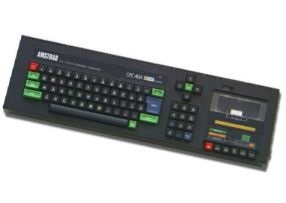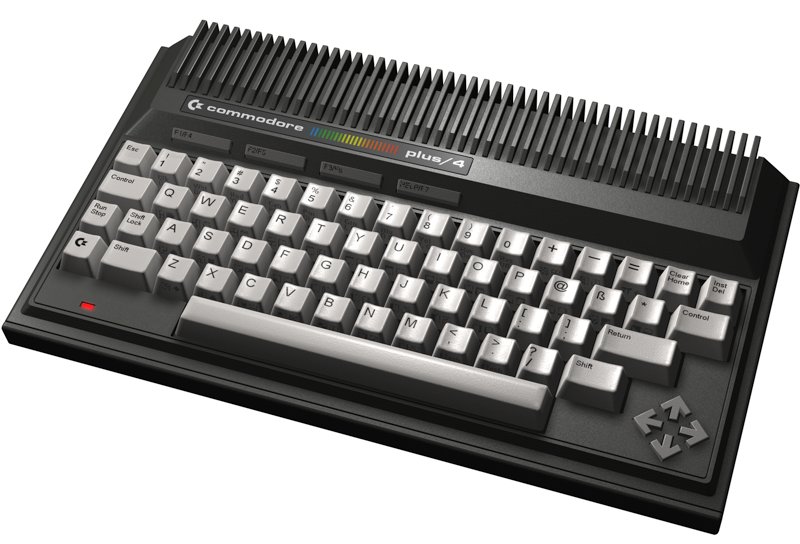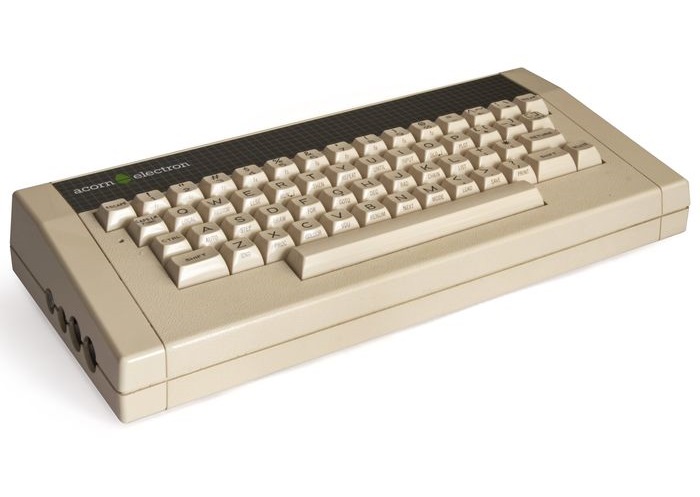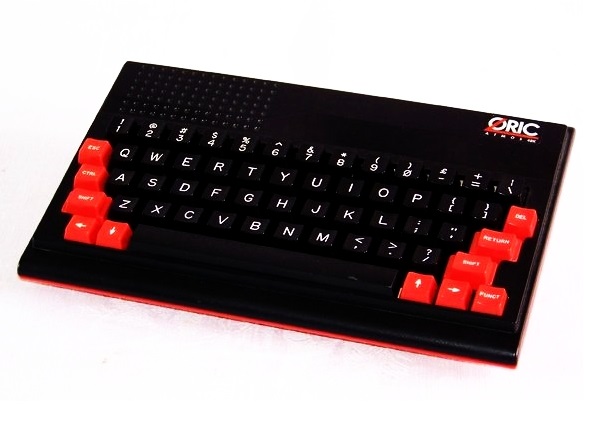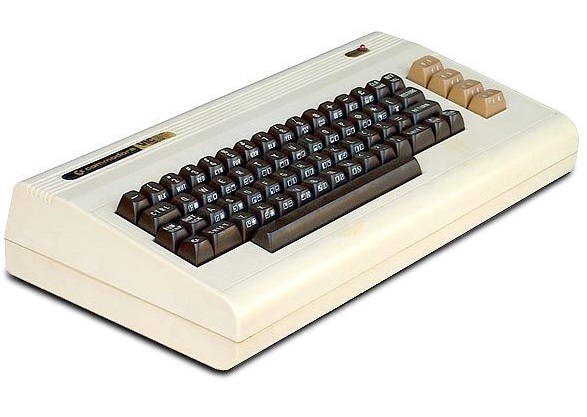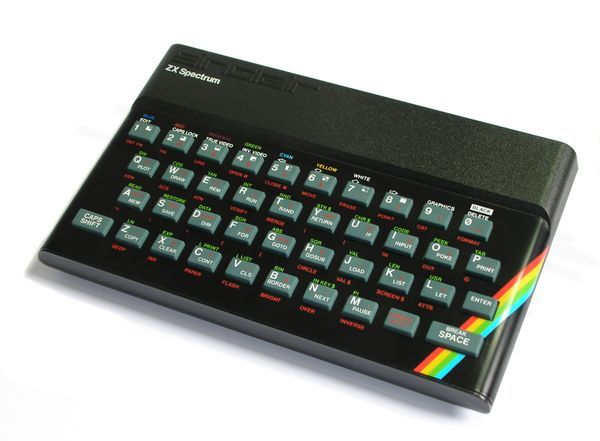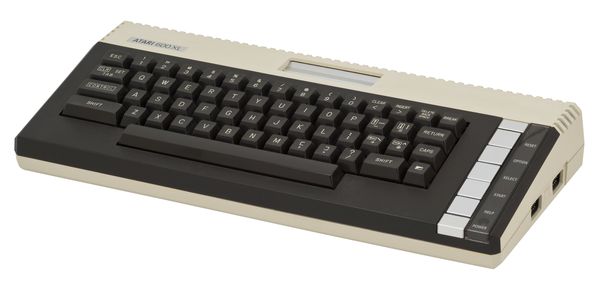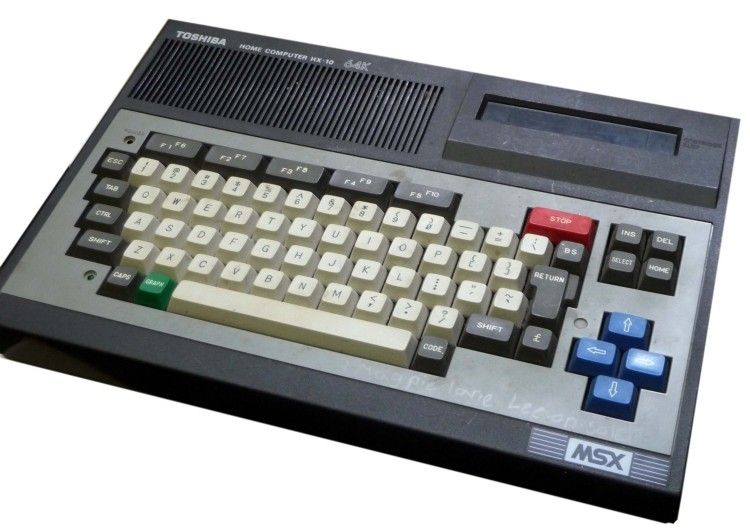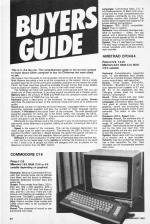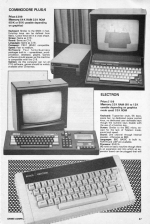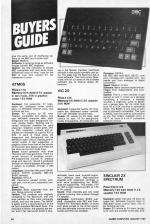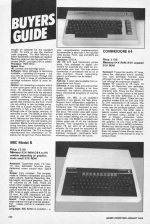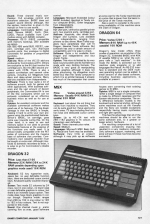
Games Computing
 1st January 1985
1st January 1985
Categories: Review: Machine | Summary: My Favourite Machines
Author: Mike Roberts
Published in Games Computing #13
This is it, the big one. The comprehensive guide to all you ever wanted to know about which computer to buy for Christmas but were afraid to ask.
Buyers' Guide
We present here the guide to end all guides, the list to end all lists, etc etc... Mike Roberts has taken a look at all the computers on the market; this is a totally accurate spec list for all the commonly available computers on the market for under 500. All these machines should be available through normal high street dealers such as Spectrum dealers, Dixons, or any of the main chain stores.
The headings are fairly self explanatory, price is the general price that you can obtain one of these machines, if you shop around you should get a cheaper quote. Memory size is the amount of ROM and RAM that the computer comes with and the actual amount of RAM that you can use.
Keyboard gives a description of the keyboard, its layout, and quality. Screen describes the graphical output of the computer along with some of its pitfalls and quirks. Sound gives number of channels and extra features. Languages refers to the programming language supplied and also the number of other language options available. A Processor is the actual 'brain' of the computer. The most popular and powerful processor for home use is the 6502 series; this includes the 6502, 6502A, 6510, and the new 7801. The next most common is the Z80 series, and some computer's use the 6809 or 9900.
I/O stands for Input/Output and is the computer's way of conversing to the outside world, either listening to a joystick, talking to a printer, or having a chat with a disk drive.
Speed is the speed of the computer. This can be processor-dependent, but other things must be taken into account. Theoretically the Z80 is faster, but in practice the 6502 outstrips it. Speed dictates the speed that games will play at. BBC games are very fast and playable. Electron games are quite slow.
Software is a short evaluation of what kind of software base the machine has.
Last, but by no means least, is my opinion on whether the computer is any good or not. I know a lot of people out there will disagree with me, so please no "my Spectrum is better than his BBC" letters!
Commodore 16
Price: £139
Memory: 16K RAM (12K or 4K useable depending on graphics)
Keyboard: Same as Commodore 64 except that function keys can be defined from Basic and the layout is different. Separate dedicated function keys and space bar.
Screen: Three modes from Basic, 320 x 200 and 160 x 200 graphics, 320 x 160 and 160 x 160 with five lines of text, and 40 x 20 text. There are 128 colours and flashing all available at the same time. The Basic's graphics handling is superb and unsurpassed. Outside Basic there is another three modes and UDGs which need to be accessed by POKEing.
Sound: Two channels of sound or one sound and one noise.
Languages: Commodore Basic 3.5. A full implementation of Basic with structuring and the most comprehensive set of graphics commands on any micro. Assembler monitor also included. The screen editor is superb and supports full screen editing and windows.
Processor: 7801 (6502 compatible).
Speed: Fast to medium.
Software: Four software packages supplied as standard - chess, two zap games and a drawing program. More software should appear as lots of these should be sold up to Christmas.
Opinion: This is a real Spectrum beater. The best value computer on the market, comes complete with software and a tape recorder.
Amstrad CPC464
Price: £229, £349
Memory: 64K RAM 32K ROM (42K useable)
Keyboard: Comprehensive typewriter style. 12 user-definable keys already defined as a numeric keypad. Dedicated cursor control keys, real space bar.
Screen: Three modes, 640x200, 320x200, 160x200 in 2,4 or 16 colours selected from a palette of 27 and 80, 40 or 20 characters per line. Changing modes does not increase memory consumption.
Sound: Three sound and one noise channel through internal speaker.
Languages: Locomotive Basic included. Very good at certain functions like graphics, sound and structuring but needs spaces everywhere which is very awkward. The editor is also rather crude.
Processor: Z80A. Speed: Fast.
Software: Amsoft, the software arm of Amstrad, is commissioning as big a range of software that it can get together. There should be lots of games out by the time you read this. The games currently out are very poor quality but this should improve.
Opinion: Good value with the inclusion of a monitor and a tape recorder. Reliability may be a problem as Amstrad has a bad reputation for this. Tape recorders can be incompatible between each other.
Commodore Plus/4
Price: £299
Memory: 64K RAM 32K ROM (60K or 50K useable depending on graphics)
Keyboard: Similar to the SX64 in feel. Function keys can be defined from Basic. Cursor keys set in a cross shape.
Screen: Same as C16.
Sound: Same as C16.
Languages: Same as C16.
Processor: 7801 (6502 compatible.
Speed: Fast to medium.
Software: Four home/business packages built in - spreadsheet, word-processor, database, graphs. Games software should appear as this machine is compatible with the C16.
Opinion: As this computer can run all C16 software, games should be widely available after Christmas.
Electron
Price: £199
Memory: 32K RAM (9K to 12K useable depending on graphics mode used) 32K ROM
Keyboard: Typewriter style, 56 keys, space bar, no dedicated cursor control keys, no dedicated user definable keys though the numeric keys double with the use of a function key.
Screen: Similar to the BBC micro, except for the lack of Teletext mode, sound and speed.
Sound: One channel through internal speaker, otherwise as BBC.
Languages: BBC BASIC is built in, FORTH and LISP are available.
Processor: 6502A. I/O none on basic machine though there is an expansion slot into which an expansion board can be plugged that will give the same sort of interfacing options as the BBC but at extra cost.
Speed: Medium.
Software: A growing range as software houses convert BBC programs.
Opinion: As this computer is almost BBC compatible with only some minor differences most of what I say for the BBC is true here except for the references to price.
Atmos
Price: £179
Memory: 64K RAM (47K useable in text mode, 39K in graphics mode) 16K ROM
Keyboard: Full typewriter, 57 keys, space bar, dedicated cursor control keys, no definable function keys, two functions per key.
Screen: 40 columns by 28 rows Teletext-compatible text display, two user definable character sets, eight foreground and eight background colours, double height, flashing and inverted attributes available for each character. Graphics screen gives 240 by 200 resolution, colours and attributes are definable on a grid of 40 by 200. In each of these areas the foreground and background can be defined in eight colours, flashing and inverted output is also supported. In graphics mode three lines at the bottom of the screen also appear, and these are the same as the text mode lines.
Sound: sound generator with three channels and noise generator. There is a certain amount of envelope control. Pre-programmed sounds to produce pings and zaps etc. Sound is produced through an internal speaker although hi-fi output is available through a DIN socket.
Languages: Extended Microsoft BASIC built-in, FORTH available, BBC-like BASIC planned.
Processor: 6502A.
I/O: Centronics parallel printer port, user port, monitor port, expansion connector.
Speed: Fast.
Software: Badly supported from day one. Range growing smaller.
Opinion: This computer was originally compared to the Spectrum, and this was justified as they were outwardly similar, and look the same. The BASIC is easier and is a structured form of the de-facto standard Microsoft basic. The keyboard is better, the graphics are better, and it has real sound which is lacking in the Sinclair machine. Interfaces are built in that would normally cost extra. The edge that the Spectrum has is more software. The more recent Spectrums will not run some of the available software due to internal design differences.
Vic 20
Price: £129
Memory: 6K RAM (3.5K useable) 20K ROM
Keyboard: Typewriter quality, 67 keys, space bar, dedicated cursor controls, four user definable function keys.
Screen: 22 column by 23 lines, eight colours for text, 16 for background, border and graphics. All characters user definable, lower case, inverted output, two character sets. High-resolution possible with expansion cartridge or with extra programming but BASIC does not support this. Two modes, 160 by 128 in eight colours and 80 by 128 in 16 colours.
Sound: three channels and one noise channel covering nine octaves through TV speaker.
Languages: Commodore BASIC supplied, compatible with PET and Commodore 64. Extended BASIC, at extra cost gives access to the Hi-res sound, and user definable function keys. Forth, Comal and Pilot are available.
Processor: 6502A.
I/O: IEEE 488 serial BUS, RS232, user port, cartridge port, joystick port, two paddle port (two analogue to digital converters).
Speed: Medium to fast.
Software: Many cassette tapes and cartridges from independents and Commodore.
Opinion: This is a nice machine to get started on and it comes as a package containing a computer, a cassette recorder, a beginners guide to BASIC and a games tape. So the initial high price for a 3.5K machine is somewhat offset. The BASIC is very easy to learn and is Microsoft-compatible. This type of BASIC was first used by Commodore on the first widely available micro in 1977 so there is a lot of compatible software around.
Sinclair ZX Spectrum
Price: £99, £129
Memory: 16K, 48K RAM (7.5K useable) 16K ROM
Keyboard: rubber mat type, 40 keys, no space bar, definable function keys or dedicated cursor control keys, five or six functions per key.
Screen: 32 colours by 24 rows, but only 22 rows are available to the user. 256 by 76 high resolution graphics supported by BASIC, two colours from a palette of eight are available in 704 areas on the screen. Foreground and background colours for each of these areas can be selected as well as whether the contents of the area are flashing or not. Two levels of intensity are also supported. 21 user defined characters are available.
Sound: Internal beeper.
Languages: Sinclair BASIC. This version is an extended form of the type used in the ZX81. The extensions do not cover structured programming or aid functions and only deal with the graphics and file handling. This BASIC is very non-standard.
Software: A lot of software is available for almost all applications, particularly games.
Opinion: When the Spectrum first appeared it was an innovation as the lowest-priced colour computer. But newer designs have arrived recently with better technical specifications and more useable memory at similar prices. The colour display is not good and a colour display cannot be produced on a few colour TVs. For editing and the method of keyword entry see ZX81. With the Spectrum there are more keywords to be fitted on the same size of keyboard. Sound is through a beeper only. The range of software is enormous.
Atari 600XL/800XL
Price: £99, £199
Memory: 16K/64K RAM (amount useable varies with graphics mode used) 26K ROM
Keyboard: Full typewriter style keyboard, 58 keys, four function keys, space bar but no dedicated cursor control keys.
Screen: 16 screen modes comprising five text modes and 11 graphics modes. Text is 40 columns by 24 line in up to 256 colours. The graphics have a maximum resolution of 320 by 192 in the biggest hi-res mode. All characters are user definable and come in predefined shapes to start with. Player-missile graphics - like sprites - are also available.
Sound: Four channel sound generator with full software support.
Languages: Atari BASIC included and these are available: Forth, Pilot, Logo, WSSM, Pascal, Microsoft BASIC. Two types of assembler editor are also available.
Processor: 6502A.
Speed: medium to fast.
I/O: Serial input/output port along with two connectors for two joysticks or paddles. Other interfaces may be added via interface bus. Slot for ROM cartridges. Cassette port will only allow connection of Atari cassette recorder at 49.99, so this must be taken into account when considering costs.
Software: the XL series of software is compatible with older models so lot of software is on sale from both Atari - which has a library of 500 titles - and from independents, including US imports.
TI-99/4A
Price: £70-£80
Memory: 16K RAM (14.5K useable) 26K ROM
Keyboard: Typewriter style, 48 keys, including row of function keys (not user-definable), space bar. Two functions per key.
Screen: 32 columns by 24 rows text, 129 characters, all user-definable, 16 colours each for foreground and background. The way colour is handled is rather odd - a colour is assigned to a particular group of characters. There are 16 groups of eight characters, so a particular colour is assigned, for example, to the letter A but will also effect B to H. High resolution graphics only available with TI plug-in cartridges.
Sound: Three channels of five octaves with noise channel.
Languages: TI BASIC is included, but cannot use machine code, so arcade quality programs cannot be written or bought on cassette for the standard model. To write or use the machine code programs, TI's Mini Memory or Editor Assembler cartridges are needed. Machine code can also be used with extended BASIC, provided 32K is added.
Processor: TMS 9900.
Speed: Slow.
I/O: joystick and cartridge ports.
Software: More software is becoming available - including US imports - but you may be forced to buy through mail order. TI sold a range of sophisticated cartridge software which is more expensive.
Opinion: An interesting computer which is now quite good value at its new low price. Its drawback is that machine code cannot be used with the standard model so there is not much arcade-type cassette software, although this is slowly increasing. However, if all the games that interest you are from TI and you are willing to pay cartridge prices, then this is a good machine. For programmers it has a line editor which, although one of the better versions, is awkward to use. The BASIC is slow but easy to use and comprehensive. Its worst features are that there can be just one statement per line and spaces are essential. Maths functions are good but string functions leave something to be desired. The computer is very well-built and looks attractive. The TI is no longer manufactured but information on its status can be got from Parco Electrics.
BBC Model B
Price: £399
Memory: 32K RAM (28K to 9K useable depending on graphics mode used) 32K ROM
Keyboard: Typewriter style, 73 keys, ten user definable function keys, dedicated cursor control keys. Space bar.
Screen: Very complex. The simplest mode is Teletext compatible and gives eight colours, flashing characters, double height, and block graphics. Text is 40 columns by 25 lines. There are seven other modes of screen operation ranging from 640 by 256 hi-res in two colours with 80 by 32 text to 160 by 256 hi-res in eight colours with 20 by 32 text. All 256 characters are user-definable in all but the Teletext mode.
Sound: Three channel music with a noise channel through internal speaker. Full envelope control is available from BASIC.
Languages: BBC BASIC is included - a very comprehensive implementation. As assembler is also built in for machine code access. Forth, Lisp and BCPL are also available.
Processor: 6502A.
I/O: RS 423 and Centronics printer ports, Four analogue to digital converters for joysticks etc. eight bit programmable user port. The tube allows connection of processors and so on to disk interface, Econet networking, speech synthesizer can be added.
Speed: Fast.
Add-ons: A great deal available from independents and Acorn.
Software: A very large and well-written range available, including a lot from Acornsoft, the maker's software arm. Many educational programs of varying quality.
Opinion: The BBC is an excellent machine if you ignore the high price. Support from independent suppliers is superb, but Acorn has been slow on the hardware side. The keyboard is very good and there is a useful set of function keys. The screen uses split cursor screen editing which is next best thing to full screen editing but not quite as easy to use. The BASIC is excellent and makes good use of all the hardware features. This computers is used by about 75 per cent of all secondary schools. So it is good for education as well as games. It also makes a good business computer, particularly with networking available for the future.
Commodore 64
Price: £199
Memory: 64K RAM (40K useable) 20K ROM
Keyboard: Typewriter quality, 67 keys, space bar, dedicated cursor controls, four user definable function keys although full use of these can only be had through an expansion program.
Screen: 40 columns by 25 rows, 16 colours, all characters user definable, lower case, inverted output, two character sets. There are four different text modes but the format is the same for all, the only difference is in the handling of the colour. There are two graphics modes 320 by 200 and 160 by 200 resolutions in 16 colours. The difference is to do with colour: one mode uses the attribute system, similar to the Spectrum, the other uses a palette system where each dot is its own individual colour, similar to the BBC or Dragon computers. Unfortunately the BASIC does not support the graphics so you must write your own routines or buy a BASIC extension. Modes may also be mixed. Eight sprites are available and although the BASIC does not support these directly instructions are given in the manual on how to achieve them.
Sound: Three channel music synthesizer. Full envelope control and waveform selection. BASIC does not support sound directly although, like the sprites, instruction is given in the manual on how to use sound.
Languages: Commodore BASIC supplied. Simons BASIC, Forth, Pilot, LOGO, Pascal available from Commodore along with BASIC compiler.
Processor: 6510 (6502 compatible with memory banking), Z80 available as option.
I/O: IEEE 488 serial BUS, RS232, user port, cartridge port, two Atari-type joystick ports, four analogue to digital converters for paddles or proportional joysticks.
Speed: Medium.
Add-ons: Most of the VIC-20 add-ons produced by Commodore will fit. Others are exclusive to the C64 that involve the cartridge port, like the Z80 second processor with CPM. There is also a speech synthesizer and several other options, including 32 Megabyte hard discs and daisy-wheel printers. Many add-ons available from independents.
Software: There is now quite a lot of software around, both for games and other applications. With business software and the vast amount of decent peripherals, the Commodore 64 is one of the few computers which can be seriously considered as an effective business micro as well as for use at home.
Opinion: An excellent computer and the available commercial software makes good use of its features. The big disadvantage is that the BASIC is simple, making it hard to write your own programs using the sophisticated features. Simon's BASIC, on cartridge, goes some way towards curing this. On the other hand, it is easy to use and memory space is not used to provide fashionable features at the expense of the functions you really need. It is almost totally compatible with the PET series of computers and the massive base of software that provides. Commodore's own cassette recorder must be bought at extra cost. Although interfaces to domestic recorders do exist, it is wise to go for Commodore's reliable recorder.
Dragon 32
Price: Less than £100
Memory: 32K RAM (30K to 24K RAM useable depending upon graphics mode used) 16K ROM
Keyboard: 52 key typewriter style, space bar, no user definable function keys, there are dedicated cursor control keys. Keyboard quality could be improved.
Screen: Text mode 32 columns by 24 rows, text in one colour, no lower case or user definable graphics in colour, but there is an inverted output option. Text mode does have block graphics in colour though. Graphics Mode ranges from 256 by 192 in one colour to 128 to 192 in four colours. Text is not supported in this mode.
Sound: One channel music generator covering five octaves, good software control.
Languages: Microsoft Extended Colour BASIC included. Identical to Tandy colour computer BASIC. Other languages from independents.
Processor: 6809E.
I/O: User port, Centronics parallel printer port, two joystick ports, cartridge port.
Add-ons: Joysticks, disc drives from Dragon and Cumana. Lots available from independents, ranging from printers to disc drives. Most Tandy suppliers have peripherals that will fit the Dragon, likewise Tandy software. But software has only a certain amount of compatibility and it is wise to check.
Software: Quite a lot available from Dragon and independents and (but check) Tandy.
Opinion: This micro is limited by its very basic sound system and its horrible text mode with very limiting formats. The BASIC is very good at manipulating screen graphics although it does not allow structuring. An altogether much better buy than the Tandy computer to which it is so similar because it already has much of the expansion that comes at extra cost for the Tandy machine and at a price that is lower than the basic initial price of the Tandy machine.
Also a point to consider is the continuing availability of this machine since the crash of Dragon.
Dragon 64
Price: Varies £200+
Memory: 64K RAM (up to 48K useable) 16K ROM
Dragon's new model offers three modes of operation: an emulation of the Dragon 32, Extended BASIC with 48K of useable RAM or as what the company calls a 'soft machine'. In this mode the BASIC is switched out for machine code programs or to add languages like Pascal. An RS-232 interface is standard and the OS/9 multi-user operating system can be added. A small amount of disc-based software, including business applications, is available at present.
MSX
Price: Varies around £250
Memory: Usually 64K RAM (24K usable) 32K ROM
Keyboard: Just about the only thing that varies from machine to machine. They can be quite good but I have used some awful ones. 73 keys including five function keys and dedicated cursor control keys.
Screen: Up to 40 x 24 text with 256 x 192 graphics in 15 colours. All characters user definable.
Sound: Three channels plus noise.
Speed: Medium.
Languages: Microsoft MSX Basic built in, Pascal and Forth may be available.
Software: Very little at present although it may pick up as software houses start converting their existing games to fit the MSX.
Opinion: MSX is not a single computer, rather a single design of computer that is made by different Japanese and Far Eastern electronics companies. The only difference between models is the keyboard and external styling, although some machines such as the Yamaha and the Sony are notable exceptions respectfully having music synthesizer and light pen options.
This has the advantage that all of the machines should be able to run the same software and, to a greater or lesser extent, hardware.
The resulting compromise of a lot of Japanese companies arguing has resulted in a very mediocre computer. Only software support, marketing, and price will see if these machines become successful.
This article was converted to a web page from the following pages of Games Computing #13.


